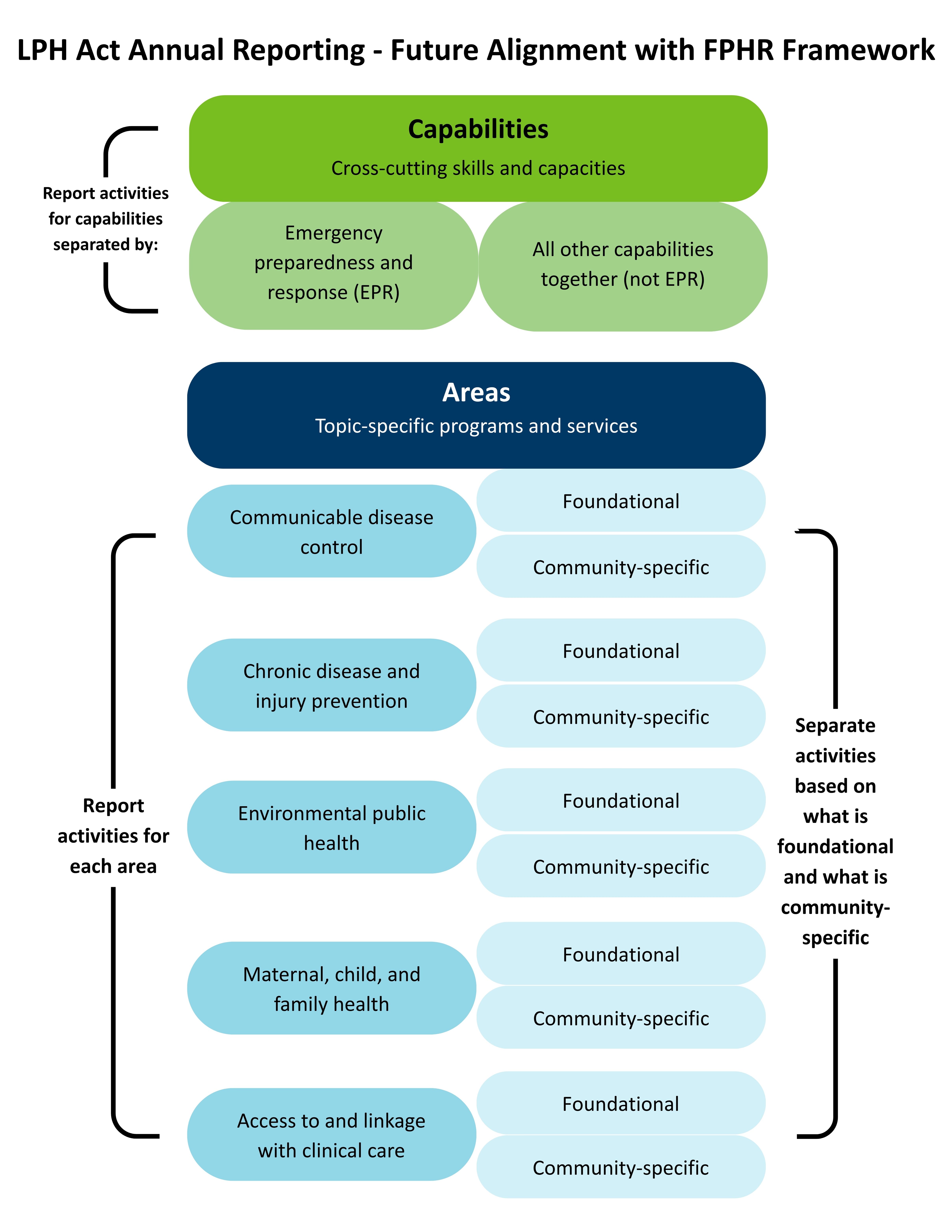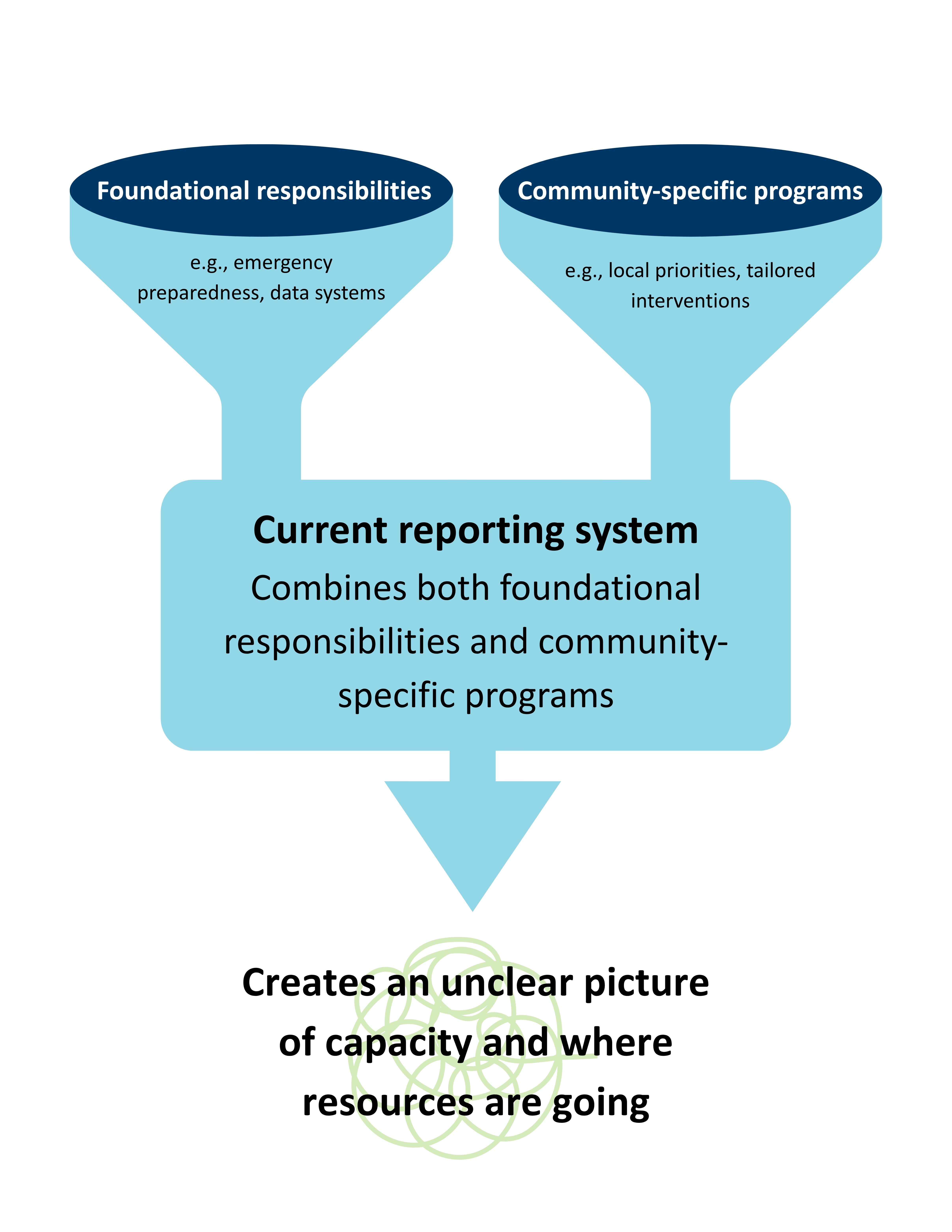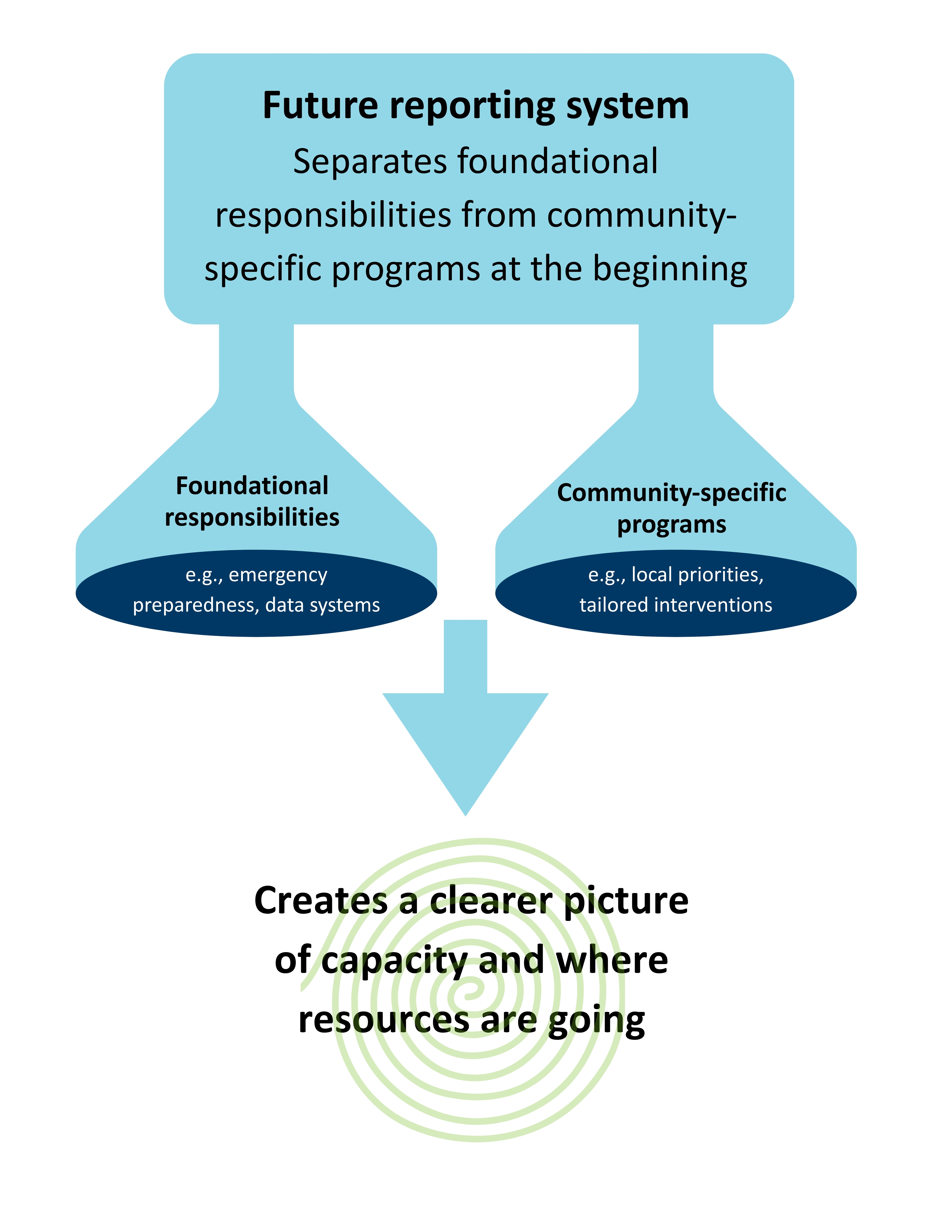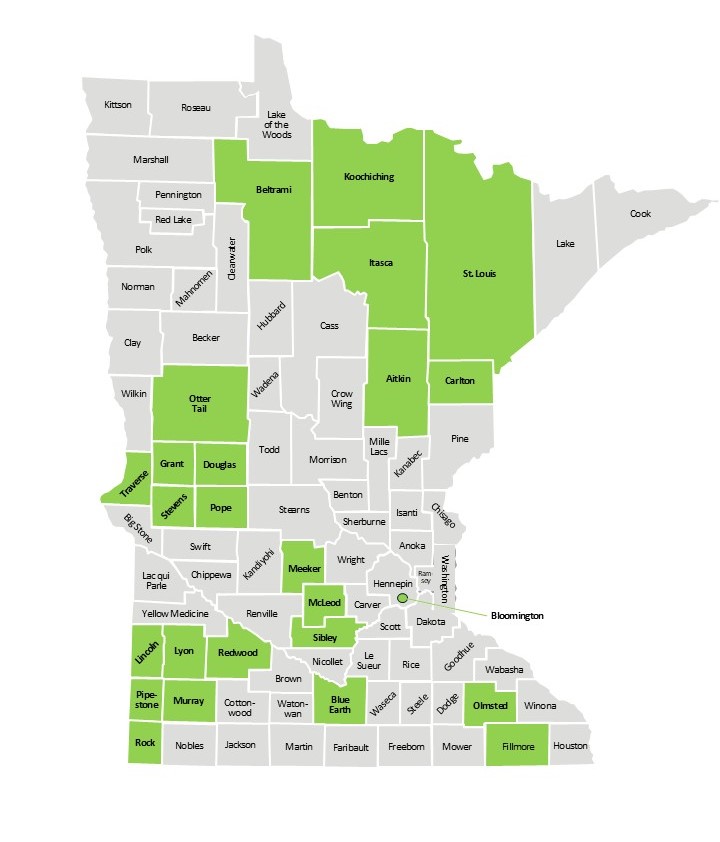Local Public Health Act Annual Reporting
Future Alignment with Foundational Public Health Responsibilities
Finance and staff reporting is transitioning to align with the Foundational Public Health Responsibilities (FPHR) Framework to synchronize with Minnesota's system transformation efforts.
On this page:
- What's happening
- Why the change is happening
- Tools and resources
- Action items to prepare
- Support
- Pilot participants
- Pilot learnings
Community health boards will begin reporting staffing and expenditure data in a more detailed way, separating foundational public health work from community-specific activities. This change starts with calendar year 2026 data, reported in March 2027. Learn more about why this change is happening.
Capabilities
Foundational capabilities are the cross-cutting skills and capacities needed to support basic public health protections, programs, and activities.
The two capability buckets that community health boards will report finance and staffing information are:
- Emergency preparedness and response
- All other foundational capabilities together, including assessment and surveillance, communications, community partnership development, equity, accountability, performance management, policy development and support, and organizational competencies.
Areas
Foundational areas are the basic public health, topic-specific programs and services aimed at improving community health. Areas reflect the minimum level of service that should be available in all communities.
The five area buckets that community health boards will report finance and staffing information are:
- Communicable disease control
- Chronic disease and injury prevention
- Environmental public health
- Maternal, child, and family health
- Access to and linkage with clinical care
Within each area bucket, community health boards will determine and code which activities are considered "foundational" and which activities are considered "community-specific services."
Community-specific services are local protections and services that are unique to the needs of a community. These services are essential to that community's health and vary by jurisdiction.

Why the change is happening
The current reporting method combines different types of work, making it hard to see where capacity exists and where it doesn’t. Without a clear picture, it's difficult to plan, identify gaps, or advocate effectively.
Why it matters: Better expenditure and staffing data helps us tell our story more clearly to funders, partners, and policymakers. Consistent, clearer data strengthens statewide advocacy for consistent and flexible funding and allows for better conversations about how to leverage the resources we have in smarter and more strategic ways.


Tools and resources
Example REDCap Expenditure Form (PDF): This sample form shows what CY2026 expenditure reporting will look like in March 2027.
- This document combines the current FPHR definitions with the REDCap Reporting Format: Foundational Descriptions and REDCap Expenditure Form (Combined) (PDF)
Example REDCap Staffing Form for Filled FTEs (PDF): Some staff occupation names will be changing to better reflect current public health workforce occupations.
- This spreadsheet crosswalks current occupations in annual reporting with future occupation categories: Staff Occupations Crosswalk (.xls)
Expenditure Workbook (.xls): This optional spreadsheet can help translate data from your local tracking system into the format required for LPH Act Annual Reporting on expenditures.
Descriptions of foundational capabilities and areas: These documents provide the descriptions of the work considered “foundational” for each area and capability. It serves as a clarification of the Foundational Public Health Responsibilities National Headlines: Minnesota Activities summary document. These definitions were approved by the FPHR workgroup and are pending SCHSAC approval.
- FPHR Definition Glossary (PDF) (scroll to glossary in this document)
- Emergency Preparedness and Response Capability (PDF)
- All Other Capabilities (No Emergency Preparedness and Response) (PDF)
- Access to and Linkage with Clinical Care (PDF)
- Chronic Disease and Injury Prevention (PDF)
- Communicable Disease Control (PDF)
- Environmental Public Health (PDF)
- Maternal Child and Family Health (PDF)
- All definitions (PDF)
Tools to help distinguish between foundational areas, capabilities, and community specific
- Decision Guide for Foundational Public Health Responsibilities: A step-by-step interactive decision tree to help determine whether an activity should be reported as a foundational capability, foundational area, or community-specific activity.
- PHAB’s Foundational vs Community-specific Services: Crosswalk & Guide: Created for health departments completing their cost and capacity tool, this guide provides general guidance and examples (sections 2 and 3) to distinguish between foundational capabilities, foundational areas, and community-specific work.
- Examples of Common Topics (PDF): This document provides examples of work categorized as community-specific, foundational area, or foundational capability.
Action items
- View the recording:
- Learn about the new changes to LPH Act annual reporting: LPH Act Annual Reporting Changes Webinar | Sept. 30, 2024
- Learn more: Review materials about the FPHR framework and what's foundational in Minnesota: Foundational Public Health Responsibilities and Framework - MN Dept. of Health
- Consider joining the FPHR Community of Practice: FPHR Community of Practice - MN Dept. of Health
- Attend office hours: Public Health Practice staff will be available to answer questions about this annual reporting shift on the following Fridays, from 10 to 11 a.m.:
- View the slides (PDF)
- Friday, Jan. 9, 2026
- Wednesday, Jan. 28, 2026
- Friday, Feb. 27, 2026
- Wednesday, March 25, 2026
- Friday, April 24, 2026
- Wednesday, May 20, 2026
- Friday, June 19, 2026
- Wednesday July 15, 2026
CHS administrators and public health directors will receive the meeting link via a CHS-PHN Update email. If you need the meeting links, please email health.ophp@state.mn.us
- Join the Basecamp: Connect with and support your peers around the state. To request access for yourself or other individuals from your agency, please email ann.march@state.mn.us.
- Frequently asked questions: Responses to questions about the staff and finance annual reporting shift can be found here: FAQs About LPH Act Annual Reporting Shift (PDF)
Support for annual reporting
If you need access to REDCap for annual reporting, please email Ghazaleh Dadres at ghazaleh.dadres@state.mn.us. CHS administrators, directors, and requested staff have access to the annual reporting projects.
If you need help troubleshooting REDCap, visit this resource page: Help with REDCap for LPH Act annual reporting - MN Dept. of Health. You can also let us know at health.ophp@state.mn.us.
For non-REDCap help and questions, email health.ophp@state.mn.us or contact your public health system consultant: Who is my public health system consultant? - MN Dept. of Health.
Pilot participants
Eleven agencies or community health boards are piloting the LPH Act annual reporting transition. The purpose of the pilot is to explore ideas and approaches, leverage opportunities, and identify challenges and solutions. Participants are testing tools, creating guidance, and sharing learnings.
The following agencies or community health boards are participating in the pilot: Beltrami, Aitkin-Itasca-Koochiching, St. Louis, Carlton, Otter Tail, Horizon (Grant, Douglas, Stevens, Pope, and Traverse counties), Meeker-McLeod-Sibley, Olmsted, Blue Earth, Bloomington, and Southwest Health and Human Services (Lincoln, Lyon, Redwood, Pipestone, Murray, and Rock counties).

Current data systems (e.g., Nightingale Notes, PH Doc, homegrown tools) require upgrades to support the reporting expectations. These upgrades come with cost and maintenance considerations.
Pilot participants are working with the vendors to develop guidance. Specifically,
- Nightingale Notes: Pilot participants would like consistency in how it’s used to report activities throughout the state, so they are working with Nightingale to come up with a guide. However, it will not be a requirement to use what the pilot develops. For those who want to use the guide, there would not be a fee. More information is forthcoming from the vendor to Nightingale Notes users.
- PH Doc: There is more variation in utilization across the state, but the pilot group is looking at working with the vendor to create a form that could be adopted or adapted.
The Foundational Public Health Responsibilities (FPHR) Workgroup has been working on definitions for activities and programs. This work is helping bring clarity, particularly around what is foundational versus community specific.
Local public health staff continue to need support in “seeing” their work within the FPHR framework.
Pilot participants want to ensure consistency in language across materials, data systems, and other supporting docs to reduce confusion and subjective interpretations. They have identified a need for common coding practices.
Some key activities (like PH nuisance, WIC, TB) are more challenging than others, so there is a desire to establish some common coding for these activities.
Identified need for consistency in coding paid time off.
There are concerns about variations in how community health boards are reporting expenditures (e.g., tax levy, not capturing unfilled positions).
There is generally a great need for developing tools, coding examples, guidance to help with statewide consistency.
Regular staff discussions, supervisor-led data entry reviews, and standing agenda items in staff meetings reinforce learning and allow real-time problem-solving as coding challenges arise.
Including financial analysts and fiscal managers in training ensures that all those involved in compiling and reporting data are aligned.
Engaging staff in this transition requires clear communication of the purpose and value of FPHR reporting. Practical examples and ongoing conversations help staff understand how their work contributes to the bigger picture.